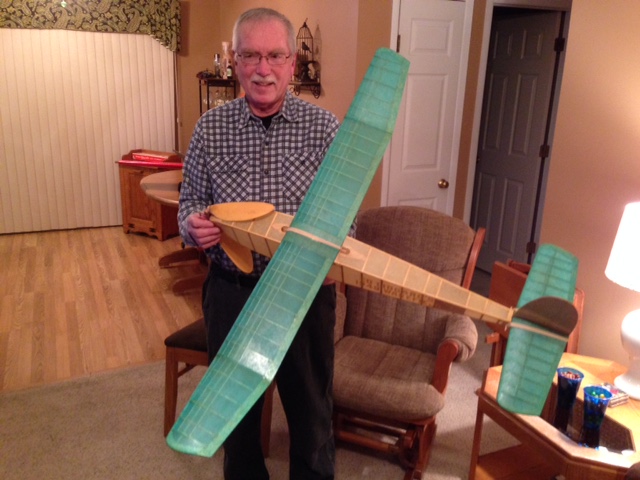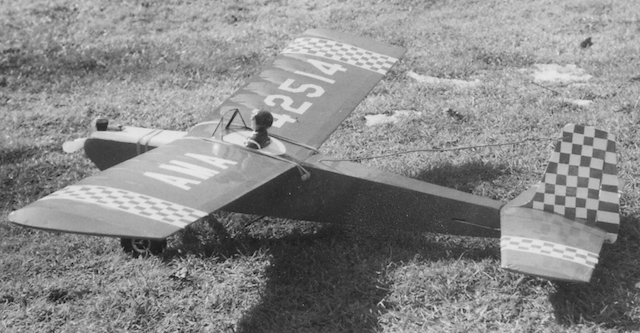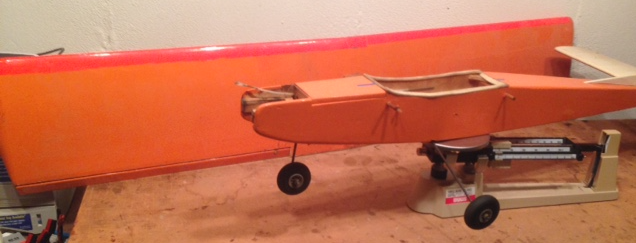 |
Flying High With Electric Power!
The Ampeer ON-LINE!
Fly the Future - Fly Electric! |
|---|
Site Table of Contents
| President: | Vice-President: | Secretary-Treasurer: |
| Ken Myers | Richard Utkan | Rick Sawicki |
| 1911 Bradshaw Ct. | 240 Cabinet | 5089 Ledgewood Ct. W. |
| Commerce Twp., MI 48390 | Milford, MI 48381 | Commerce Twp., MI 48382 |
| (248) 669-8124 | (248) 685-1705 | (2480 685-7056 |
 | ||
| Board of Directors: | Board of Directors: | Ampeer Editor |
| David Stacer | Arthur Deane | Ken Myers |
| 16575 Brooklane Blvd. | 21690 Bedford Dr. | 1911 Bradshaw Ct. |
| Northville, MI 48168 | Northville, MI 48167 | Commerce Twp., MI 48390 |
| (248) 924-2324 | (248) 348-2058 | (248) 669-8124 |
| The Next Meeting: Date: Wednesday, March 13 Time: 7:30 p.m.
Place: Ken Myers' house | ||
| The January 2019 EFO Meeting The planes and projects noted at the January meeting. | My Personal History With the Falcon 56 Ken Myers describes his long personal history with the Carl Goldberg "Falcon" series of planes. |
| Another Glow To Electric Conversion Program Ken Myers shares his latest and simplest glow to electric conversion information. | Indoor Flying Season, 2018-2019, Southeast Michigan Dates and times for Indoor flying in our area. |
| Comments and Thoughts Regarding the Avionic/Fly Dream 2.4 GHz Radio System Two Ampeer readers share their thoughts about the Avionic Radio System reported on in the February 2019 issue. | Skymasters' Electric Night Fly and Fly-in Info on this upcoming annual event. |
| Upcoming 35th Annual Mid-America Electric Flies 2019 Info on this upcoming annual event. | |
Richard Utkan, EFO vice-president, brought a version of a 1949 Wakefield rubber powered model that he'd recently purchased. It has about a 42" span with about 242 sq.in. of wing area. His plan is to convert it to an electrically powered RC model. He got some advice on what power system might be usable. 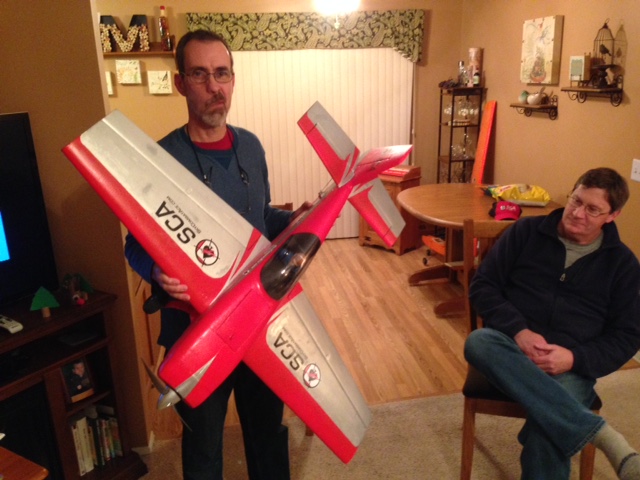 Owen Morgan brought in his repainted Weekender Extra 330. Owen noted that the stock motor had been replaced to avoid the reported motor problems with that ARF. The July 2014 and September 2014 issues of the Ampeer have a review of this plane and notes about the motor problem. He painted it to match the full size Extra that he had a flight in several years ago. After sharing the details on his model, the video of him riding in the Extra was shown. Owen's Flight in an Extra Thanks for sharing that video with us Owen! Next a video was shown of a new-to-the-market LiPo safety bag. The bag is the Pyroloc Fireproof Document Bag and is available through Amazon. The members, as a whole, didn't feel that the test in the video did a good job of demonstrating whether the bag would do a good job of containing a fire. More information about this bag is available on RC Groups. Ken Myers shared his personal history with the Carl Goldberg Falcon 56. 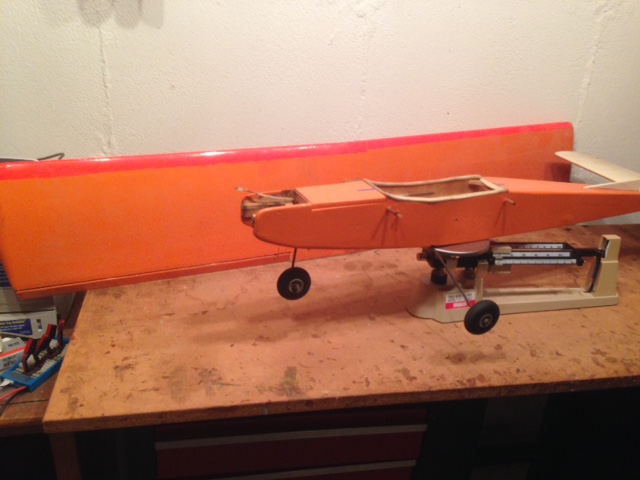 He shared a Mk II glow powered version that he another fellow built sometime in the early 1980's. He's planning on converting it to electric power. He also shared a new, in the box, Junior Falcon, that he's planning to build as an electric powered version. 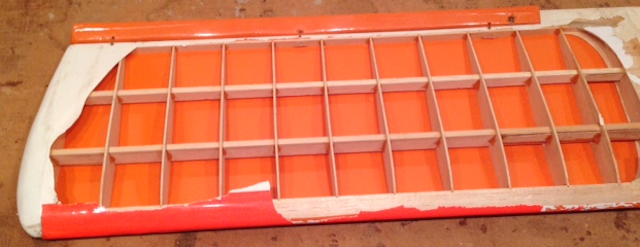 He removed the cracked and brittle Monokote from the Mk II's wing panel to show the balsa, spruce capped, double spars used in the Mk II's design. He noted that the original and Deluxe versions did not have the spruce cap strips on the balsa spars. Several of the members were particularly interested in seeing the Junior Falcon kit contents, including the die-crushed balsa parts and original plans. Because of the interest in the plans of "yesterday", Ken also shared the plans from two of the planes he built during the building season of 1962/1963. Many folks found the built-in radio system box of the DeBolt LiveWire Trainer interesting, as well as how the receiver was suspended by rubber bands. It was Ken's first RC model and it was controlled by a galloping ghost system. The system controlled the rudder and elevator. There was no throttle control for the British made diesel 0.09 engine. Ken discussed his 1963 Minnie Mambo in previous issues of the Ampeer, including the restoration and rebuild of a 1963 version. The article is in the March 2014 Ampeer. 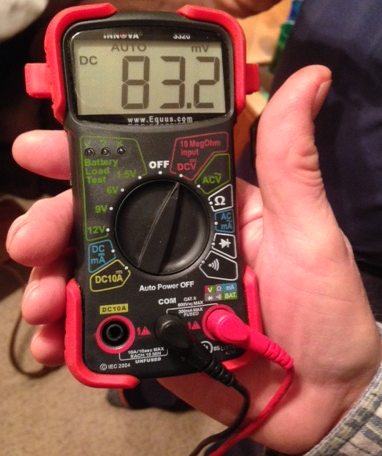 Bob Blau brought along a new multimeter that he'd picked up on Amazon. It is the Aenllosi Hard Case for INNOVA 3320 3340 Auto-Ranging Digital Multimeter. He likes it a lot and was impressed by several of its features. He noted that the Innova 3320 is the best, inexpensive one, he has ever used. 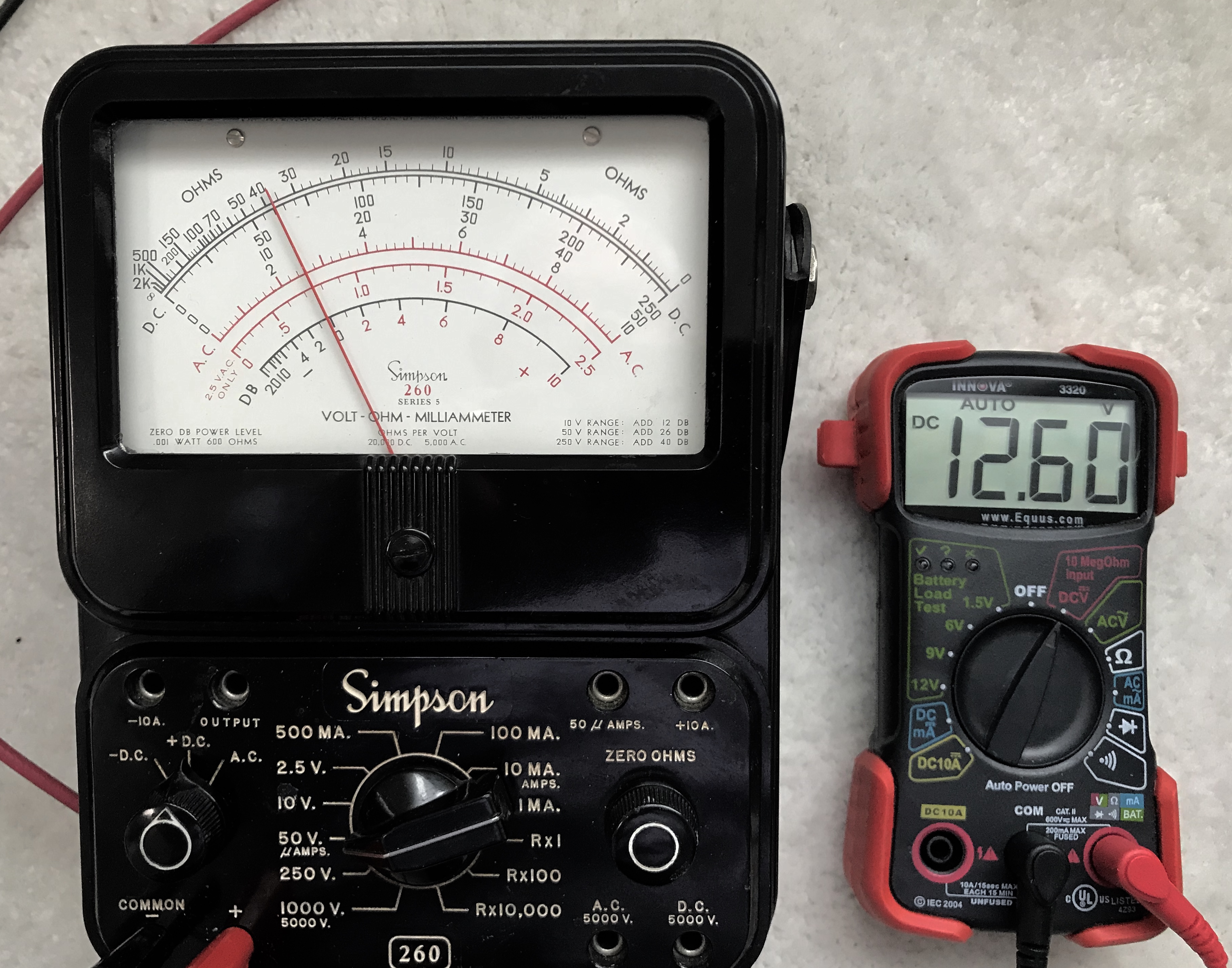 He also shared an analog multimeter that he's had for many years. My Personal History With the Falcon 56
The model I showed at the EFO meeting was a Goldberg Falcon 56 Mk II. It was not originally my plane, but I had helped in its construction. The original Carl Goldberg Models Falcon 56 kit came out in 1962. The first one I ever saw was my uncle's, Richard (Dick) Myers. I saw it either in late 1962 or early 1963. I remember seeing the kit being built in his basement while my uncle was helping me build my first RC model, a DeBolt Livewire Trainer. The original was for single to 3-function radio systems and had considerable dihedral in the wing. At that time reed-type radios were somewhat popular, so it was also shown to be used with a 6-channel radio, which is what a 3 function reed radio was called. It could also be used as a rudder only plane, single channel. My uncle's was controlled by a ground based transmitter with a pulser attached and a Mighty Midget motor pulsing the elevator and rudder and there was also a button for 'quick blip' throttle up and down. There was a second version of the Falcon 56, but it was not called the Mk II. The box art had been changed slightly to include a recommendation for some larger displacement glow engines. The original airframe had only slight changes to it. The box art also called it a "DELUXE KIT". It had the option for a wing with less dihedral for use with ailerons.  I'm not sure when the Mk II kit became available, but it was sometime in the 1970s. There were several airframe changes made to accommodate even larger glow displacement engines and the wing structure was 'beefed up' by adding spruce strips to the top and bottom of the spars. 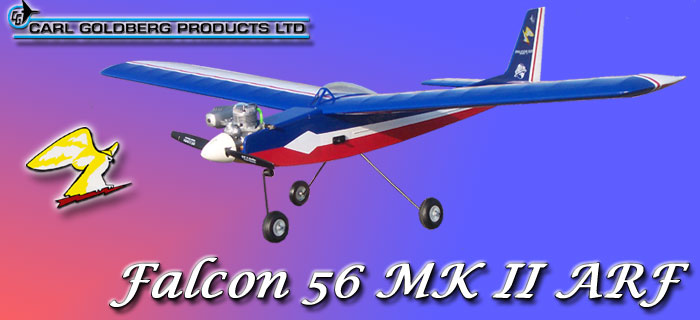
The Box Top for the ARF Version glow engine. The final iteration was the Falcon 56 Mk II ARF, which came out in 2008. There was also a Senior Falcon. It had a 69" wingspan and the recommended power was a .60 glow engine. The JR. FALCON had a 37" wingspan with an .049 glow engine (Cox) recommended for power. I built my first Junior Falcon in Korea in 1968. I purchased a somewhat strange Futaba radio system for it and flew it, briefly, with rudder and elevator control. Unfortunately, it dove into the bridge works of the engineering unit on our base near Seoul. I brought the radio system home with me and many, many years ago give it to Pete Waters, who then operated a radio business known as Kraft Midwest. 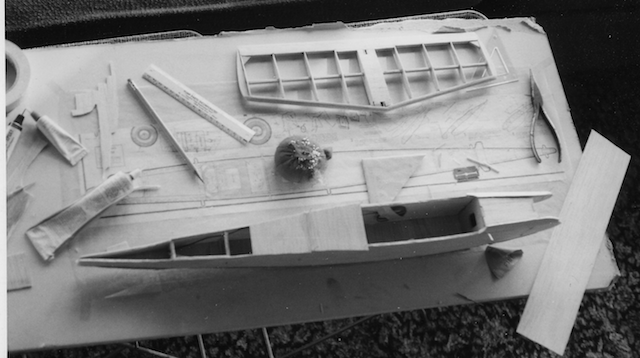
2nd Junior Falcon Under Construction I built my second Junior Falcon while living on Walled Lake in Walled Lake, MI in the winter of 1970/1971. Besides my plan to convert the Falcon 56 Mk II, shown at the meeting, I have a new, in the box Jr. to build and convert to electric power. 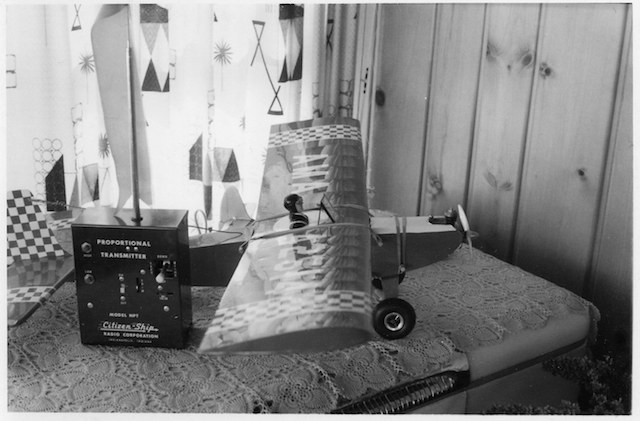
The photos of 1971 Junior Falcon show my Citizen Ship pulse radio that used a Rand actuator to control the elevator and rudder. Also note that I even preferred taildraggers back then as well as putting my own twist on the design. Actually, I've been planning on the Junior Falcon conversion since 1999! My original thoughts are in the April 1999 issue of the Ampeer. I am glad that I waited another twenty years before starting this one, as it will be much lighter than if I'd built it in 1999! Another Glow To Electric Conversion Program Over the year's I have suggested, and created, several different methods for selecting electric power systems to convert glow planes to electric power. I presented the most recent one to the Midwest RC Society at their January, 2019 meeting. While regular readers of the Ampeer may find this information redundant, could you please share it with a flying buddy that might want to convert his glow plane to electric. Ken Myers presented an in-depth method for selecting power systems for electrically powered planes. It was called "Selecting an Electric Outrunner Motor Power System for an ARF, Kit or Plans Built Electrically Powered or Glow Conversion Prop Plane". The method that he presented streamlined the process so that only a few inputs, that could easily be obtained by a glow flier, are required by the user. This method simplifies the method even more. Ken's database for Drive Calculator
Ken's Drive Calculator Spreadsheet
Ken's Drive Calculator Worksheet
Pen or Pencil - To write down information gathered on the worksheet.
Scale for weighing - To measure the weight of the glow plane. The following is a copy of the annotated worksheet.It is presented here to show how easy it is to gather the inputs and analyze the results of this method. Photos are used for illustration purposes in this article, but not on the actual spreadsheet. An INPUT for the Ready to fly (RTF) weight: (cell B4) Only one of the lines will be completed. It depends on how the ready to fly (RTF) weight is measured and/or calculated. RTF weight in ounces: _________________ oz.
Prop Selection INPUT: (cell B5)  This measurement is made with the plane setting level on its wheels when measured from a flat surface to center of prop shaft of the glow engine. _________ in. 1. Open the spreadsheet The first time you open the spreadsheet some of it will be filled in, as it was used for the example plane, a Falcon 56 Mk II. A. Input YOUR plane's name in (cell B3)
Cell B10 Shows the recommended largest prop diameter for flying off of grass Cell B11 Shows the recommended largest prop diameter for flying off of pavement Cell B15 shows the lowest pitch prop to try & Cell D15 the largest pitch to consider for the flying off of grass diameter. Cell B16 shows the lowest pitch prop to try & Cell D16 the largest pitch to consider for the flying off of pavement diameter. Only APC thin electric (E) props should be used I’ve created a chart on the spreadsheet showing the APC E thin electric props to consider between 5 inches in diameter and 16 inches in diameter. If you require a prop diameter less than 5" or greater than 16", visit the APC prop Website. The APC prop link is also on the spreadsheet. If it doesn't open from the spreadsheet in your browser, copy and paste the link to the browser. Not all four of the prop inputs are required. If you fly only off of grass, input only the diameter and pitches recommended for flying off of grass. If you fly only off of pavement, input only the diameter and pitches recommended for flying off of pavement. Note the output in cell B25. Look at the Cobra motor weight chart on the spreadsheet and select a weight class that is just greater than the weight noted in cell B25. Input that motor weight into cell B27. 2. Open Drive Calculator It can be opened by double clicking on Ken's database (DCbaseMyers.dcd) Follow the procedure, shown on the spreadsheet, for the inputs for Drive Calculator. The graphics shown on the spreadsheet, with values in them, are examples and the actual inputs will vary from what is seen, but the input positions and clicks are the same. Use the data from the completed spreadsheet to complete the following to select a brushless outrunner motor on the printed worksheet: The motor weight will always be the same. Motor weight: (cell B27) _________ g Kv Ranges from the spreadsheet:
I highly recommend looking at Cobra motors first. You can also look for any brand of motor that weighs about the motor's noted weight and falls into the Kv range for the desired cell count. A Google search using brushless motor followed by the desired Kv will yield results.
Kv values are in even units, so round as necessary.
Sometimes the motor weight is noted in the Google search results and sometimes the link will have be clicked to find the weight. ESC amp ratings from the spreadsheet:
LiPo milliamp hour rating (mAh) from spreadsheet
You will probably get more than one "Good Choice" recommendation from the spreadsheet. Note the recommended battery for each "Good Choice". The mAh size (capacity) may have to be rounded up or down to find a real LiPo battery with the number of cells and mAh size you are looking for. I recommend the Hyperion G5 series from RC Dude. You can also ask a buddy, that flies electric, what he/she uses. For the Falcon 56 Mk II, the recommended battery for 3S is 3740mAh. DON'T WORRY ABOUT the C RATING! For 3S, the Hyperion G5 has a 3S 3300mAh and a 3S 4000mAh. Choose the lower mAh. G5 3S 3300mAh: weight: 266g, dimensions: 25 x 47 x 137mm or 0.98" x 1.85" x 5.39" The recommended battery for 4S is 4S 2830mAh. For 4S, the Hyperion G5 has a 4S 2500mAh and a 4S 3000mAh. Choose the lower mAh. G5 4S 2500mAh: weight: 205g, dimensions: 105.5 x 34.1 x 26.8mm or 4.13" x 1.34" x 1.06" You could choose between the two by weight, with the 4S being lighter. It is a good idea to choose by battery dimensions, that way you'll know that the battery should actually fit in the plane where you want it to go. Make a foam, or cardboard, 'box' and actually fit it in the plane where the battery would go. 
Dummy LiPo Batteries, Constructed from Cardboard for the Falcon 56 MK II Whatever works best for you is the best way to do it. Roger Wilfong, Midwest president, suggested, at the Midwest meeting, that you make the "dummy" LiPo battery a bit longer than the dimensions noted on the Website to allow for the wires coming out of the battery that will not bend. I'd recommend about 1/2" or about 10mm. I sincerely hope you give this method a try. Please let me know how any of your conversions turn out for you. Indoor Flying Season, 2018-2019, Southeast Michigan Tuesdays, October 30 through April 16, 10 a.m. - 1 p.m.
Ultimate Soccer Arenas
Single Flying Session - $10
All pilots MUST have proof of AMA Membership
Spectators Welcomed
More Information is available here.
Support your local hobby shop because they support us! Wednesdays, November 7 through April 24, 12:30 p.m. - 2:30 p.m. Legacy Center
Drop in Flying Session - $10 Spectators Welcomed and free There may be exceptions or changes around the holidays.
Return to "What's In This Issue" Comments and Thoughts Regarding the Avionic/Fly Dream 2.4 GHz Radio System I received a couple of comments regarding the inexpensive Avionic radios system that was presented in the February 2019 Ampeer. Here are a few of the emails that I received. From Joe Hass: Thanks for all the research and writing. However I think it proves the point that there is no economy in purchasing such a system. You two guys are experts and you had a hard time getting the info and implementing it. If a newbie is not wasting their own time they are wasting the time of experts like you to guide them through getting the system running. Much better to buy something name brand, preferably from a local source, and get on with the enjoyment of flying. One man's opinion anyway. Joe Hass From David Hipperson: Dear Ken, Just a few words about the Fly Dream. For several years, Fly Dream receivers and modules were available in Australia through a gentleman called Hutton Oddy in Sydney. The transmitter aspect was either via plug in Modules or, like my old Futaba EX6A, hard wired in. A friend of mine successfully used his system in a Multiplex transmitter and JRs were so they were quite common. Of recent times I have seen them less here but as my old Futaba is getting a bit long in the tooth I am now setting up a Taranis Q7 to use the Fly Dream. To be fair, most of my flying is done with my two Spektrum units, but I remain a firm fan of the Fly Dream. Over the years through which I've used it, I have done extensive, although not empirical tests, where the receivers work solidly at almost ridiculous distances including long distance at low level. The receivers are terrific being small in size and very light, which can be handy. I have no connection with Fly Dream other than being a satisfied customer. Regards,
Skymasters' Electric Night Fly and Fly-in
The Skymasters' Annual Electric Night fly will be held on Saturday, June 8 and the electric fly-in is on Sunday, June 9. More details will follow when they become available. 35th Annual Mid-America Electric Flies 2019
The 7 Mile Rd. Flying Site, Salem Twp., MI
Contest Directors are:
Flying both days at the Midwest R/C Society Flying Field - 7 Mile Rd., Salem Twp., MI Registration: 9 A.M. both days
Pilot Entry Fee: 18 and over, $15 Sat. - $10, Sunday, (ask about the family rate),
Saturday's Awards
Sunday's Awards
Planes Must Fly To Be Considered for Any Award
Open Flying Possible on Friday
Potluck picnic at the field on Saturday evening. Come and join us for two days of fun and relaxed electric flying. Come, Look, Listen, Learn - Fly Electric - Fly the Future!
Special Events Again this year for NCM (Not Conventional Materials) aircraft
Foam Flurry for NCM aircraft:
>b>Most Unique NCM Aircraft Award:
To locate the Midwest R/C Society 7 Mile Rd. flying field, site of the Mid-America Electric Flies, look near top left corner of the map, where the star marks the spot, near Seven Mile Road and Currie Rd. Link to the map. The field entrance is on the north side of Seven Mile Road about 1.6 Miles west of Currie Rd.
Because of their convenient location and the easy drive to the flying field, the Comfort Suites and Holiday Inn Express in Wixom, MI have been added to the hotels’ listing. They are only 10 miles northwest of the field and located near I-96 and Wixom Road. See the map-hotel .pdf for more details.
To Reach Ken Myers, you can land mail to the address at the top of the page. My E-mail address is: KMyersEFO@theampeer.org |
